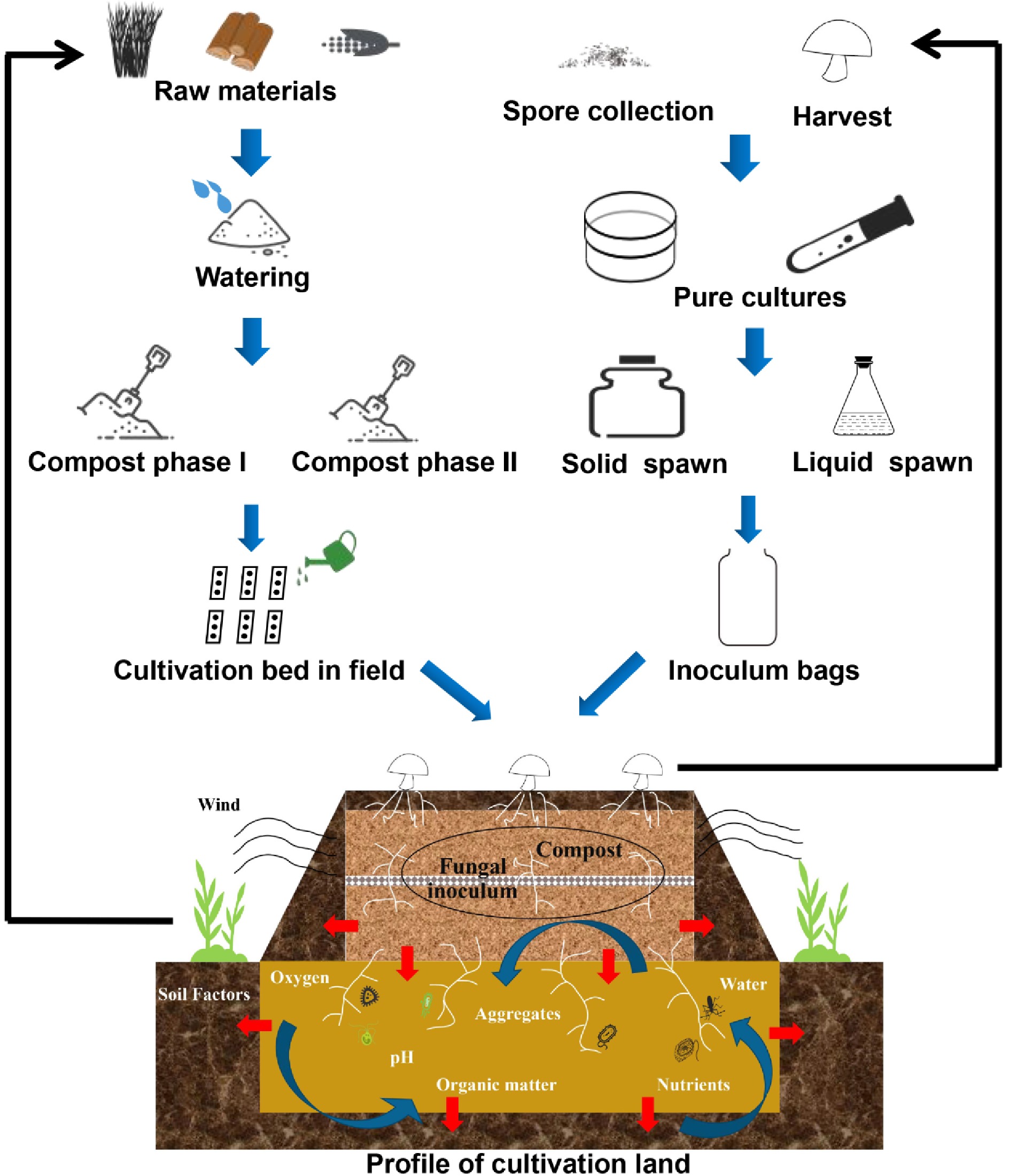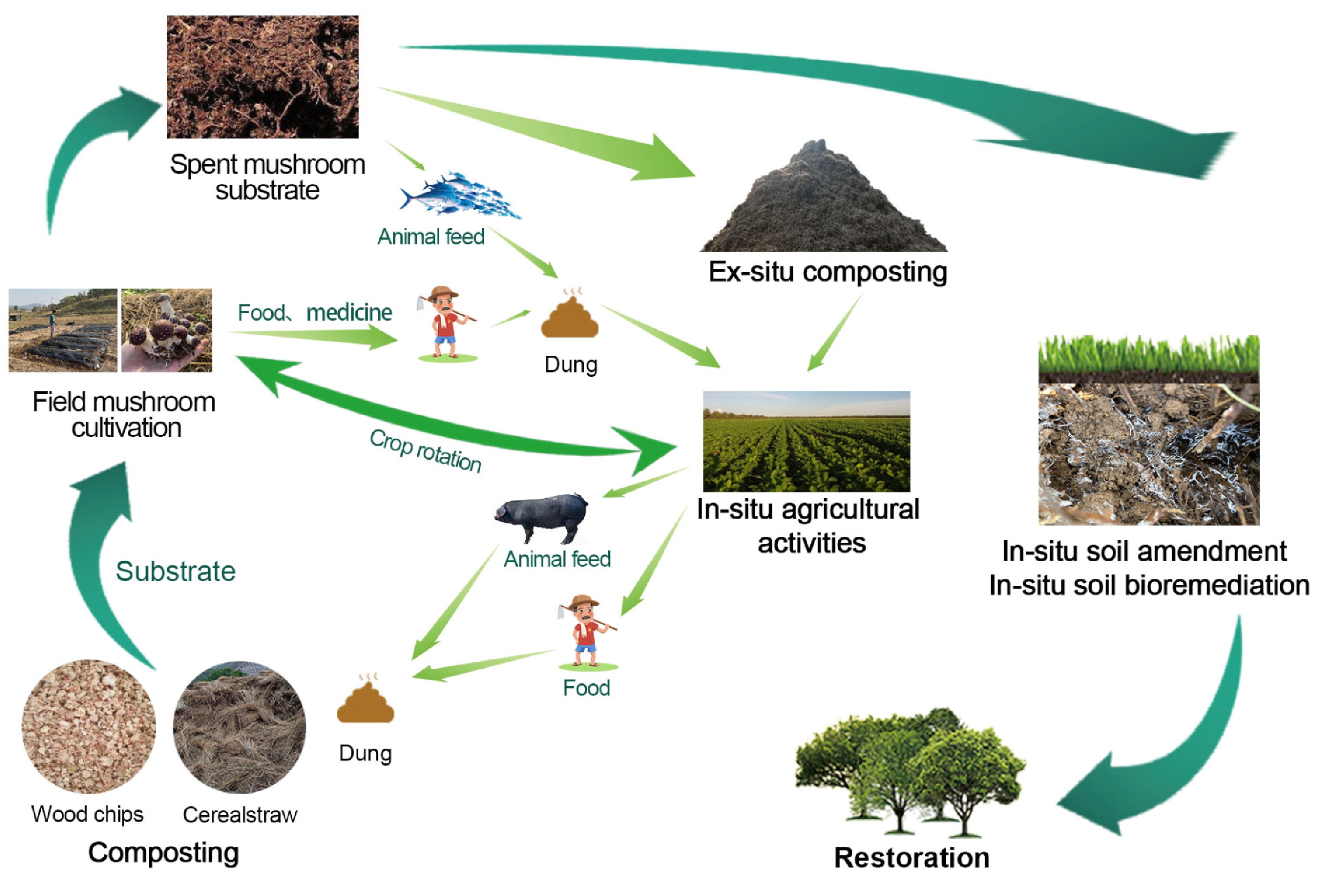-

Figure 1. Field mushroom cultivation process. The fungal fruiting bodies are collected to prepare pure cultures, spawn and inoculum bags in lab conditions. Wood sawdust and agricultural wastes from farmlands are used to prepare compost. Inoculum bags and compost are applied in fields for mushroom production.
-

Figure 2. Cord-forming mycelial network observed during field cultivation of Stropharia rugosoannulata in Honghe, China. (a) Mycelium colonized on substrate. (b) Mycelium invade to soil from growing substrate. (c) Mycelium transmission in soil. Scale bars: 1 cm. Photo credit: Yuwei Hu.
-

Figure 3. Roles of field cultivation of mushrooms in soil nutrition cycling. In the first step of the field mushroom cultivation process, various kinds of waste from agricultural activities are gathered and used as raw material for mushroom-growing compost. The final fruiting bodies provide food and medicinal resources, and the spent mushroom substrate could be used in soil remediation, enhancing agricultural activities. Finally, the soil organic matter increases, helping to restore soil ecosystems.
-

Figure 4. Carbon cycling in soil during field mushroom cultivation. Fungal mycelium in mushroom-growing substrates enable carbon to enter soils and facilitate carbon cycling. Carbon flows to fruiting bodies and becomes food; to carbon dioxide through microbial respiration; to spent mushroom substrates post-harvest; and to soil organic matter through weathering. In addition, agricultural waste produced by agricultural activities functions as the source of carbon in growth substrates.
-
Species Raw materials for compost Yield/biological efficiency Nutritional value/bioactive compounds (dry weight) References Agaricus bisporus Wheat straw; chicken manure 107.3 ± 5.37 kg per ton of dry weight compost Crude protein 194.1 ± 11.65 g/kg, crude fat: 17.8 ± 1.25 g/kg, total carbohydrates: 686.4 ± 41.18 g/kg, crude fibre: 73.1 ± 6.58 g/kg, ash: 101.7 ± 6.10 g/kg, energy value: 345 ± 27.60 kcal/100 g [26] Agaricus subrufescens (Syn. Agaricus blazei, Agaricus brasiliensis) Wheat straw, horse manure 40.0–241.4 g/kg of dry weight compost O-alkyl-C group: 51.39−62.61 ppm, antioxidant activity: 36.48%−90.07% (scavenging ability of 1,1-diphenyl-2-picrylhydrazyl radicals) and 43.94%−98.47% (scavenging ability of 2,2-azino-bis-(3-ethyl-benzothiazoline-6-sulfonic acid)) [25] Coprinopsis cinerea (Syn. Coprinus cinereus) Sisal decortications residue, calcium sulfate Yield: 238 ± 2.1 g/kg wet weight compost, biological efficiency: 68 ± 0.72% nd [55] Phallus impudicus (Syn. Dictyophora indusiata) Formula 1: Bamboo chips (100%), formula 2: sugarcane bagasse (78%), wood sawdust (20%), others (2%). Yield: 124.77 g/m2 (formula 1), 104.33 g/m2 (formula 2) Protein: 17.87 (g/100 g), total carbohydrate: 54.98 (g/100 g), crude fat: 0.63 (g/100 g), crude fibre: 11.47 (g/100 g), ash: 8.54 (g/100 g), total amino acids: 16.32 (g/100 g), the proportion of total amino acids in the protein: 91.33% [23,56] Lepista sordida Rice straw 89% ammonium phosphate 2%, calcium carbonate 1%, calcium sulfate 3%, rice bran 4%, urea 1%. Yield: 93.1−287.5 g/kg nd [57] Stropharia rugosoannulata Wood sawdust 68%, wheat straw 22%, Corncobs 10%. Yield: 4,836.52 ± 186.86 g/m2 Protein: 25.75 (g/100 g), fat: 2.19 (g/100 g), carbohydrates: 53.92 (g/100 g), crude fiber: 7.99 (g/100 g), ash: 8.72 (g/100 g), free amino acid: 16.72 (g/100 g), the ratio of essential amino acid to non-essential amino acid: 64.00%. potassium: 34,750.0 mg/kg, phosphorus: 8,168.40 mg/kg, manganese: 40.60 mg/kg, Calcium: 151.90 mg/kg, iron: 244.1 mg/kg, copper: 16.00 mg/kg, zinc: 54.40 mg/kg, sodium: 47.54 mg/kg [24] Pleurotus flabellatus Sisal decortications residue, calcium sulfate Yield: 290 ± 1.23 g/kg wet weight compost, biological efficiency: 65 ± 1.37% nd [55] Volvariella volvacea Rice straw; animal manure Yield: 92−482 g/kg substrate Ash: 8.6%−11.5%, protein: 37.2%−48.9%, carbohydrate: 19.0%−26.9%, fat: 9.3%−12.2%, fiber: 9.0%−18.6%, potassium: 4.8%−5.68%, phosphorus: 1.18%−1.27%, sodium: 0.23%−0.58%, Calcium: 49.8−152.6 mg/kg, iron: 230−301 mg/kg, copper: 30.7−73.3 mg/kg, zinc: 94−123 mg/kg, manganese: 45.9−52.9 mg/kg. [22] nd, not determined; Syn, synonym. Table 1. Compost-based field cultivation of edible mushroom species, including growth substrate, yield/biological efficiency, and nutritional value for listed species.
-
Mushroom species Inoculum type Roles as remediator and target pollutants References Agaricus bisporus Fungal culture Degradation of three-ringed PAHs, metabolism process occurred with the aid of laccase and versatile peroxidase. [128] Spent mushroom compost Biosorption of textile dye by spent mushroom compost was attributed to the activated carbon contained in spent mushroom compost, and the process is spontaneous and exothermic. [131] Spent mushroom compost Inoculation of spent mushroom substrate without previous treatment showed certain PAH biodegradation in Pb-PAH co-polluted soil, and the re-inoculation of fungus exhibited high levels of ligninolytic activity, while the application of spent mushroom substrate produced slight Pb mobilization (< 0.3%). [133] Spent mushroom substrates/raw materials Adsorption of Cd, Pb and Cu by spent mushroom substrates and their raw materials removed heavy metals from polluted soils, and the process could be attributed to electrostatic attraction, complexation, carboxyl group and N-alkyl effects. [132] Agaricus subrufescens Spent mushroom compost Crude enzymes extracted from spent mushroom compost were used to test the degradation of metsulfuron methyl, and oil rape (Brassica napus L.) was used as a plant indicator species in the growing medium. It was concluded that complex enzyme fractions degraded metsulfuron methyl significantly when incubation time is over 72 h. [130] Flammulina velutipes Liquid culture/
quartz cultureBiodegradation of polyvinyl alcohol examination in both liquid and quartz sand culture, and the results showed that unsubmerged cultivation is more suitable for the biodegradation of polyvinyl alcohol. [134] Coprinus comatus & Pleurotus eryngii Mycelium substrate bags Co-incubation exerted the best remediation effect on co-contaminated soil. High yield of mushroom production (1.04−2.60 mg/kg of Cd concentration in different treatments), the removal rates of endosulfan in all treatments were over 87%. [135] Ganoderma lucidum Mycelium with potato dextrose agar Sufficient amount of ligninolytic enzymes were produced for lindane degradation in vivo, which shows the potential for bioremediation in situ. A maximum of 75.50% lindane degradation after a 28-day incubation period under liquid state fermentation, and 37.5% lindane degradation under solid state fermentation were measured in the experiment. [136] Irpex lacteus/Pleurotus ostreatus Mycelium with wheat straw-based pellets spawn Both fungi could oxidize and decompose the aromatic moiety of polychlorinated biphenyls in soils, and results showed contaminant removal rates of 18.5%, 41.3%, and 50.5% from the bulk, surface, and rhizosphere soils respectively. This experiment showed the potential for large-scale remediation of polychlorinated biphenyls contaminated soil using these fungal species. [137] Lentinula edodes Spent mushroom substrate Spent mushroom substrate and acclimated sewage sludge show degradation rates beyond 94% of PAHs in soil and acclimated sewage sludge improved bacterial abundance, while spent mushroom substrate improved the fungal population and had a better effect on degradation by ligninolytic enzyme [138] Spent mushroom substrate Organic amendment of cadmium-dichlorophen co-contaminated soil, pollutants removal of soil linked to microbial properties, soil respiration, and ligninolytic enzymes. [139] Lentinus sajor-caju/ Pleurotus ostreatoroseus Mycelium with potato dextrose agar The mycelium growths in agar medium were affected by different concentration of irons, and L. sajor-caju was able to produce the largest mycelial dry mass (20 ppm of iron), while P. ostreatoroseus also has potential in the iron remediation process. [140] Lentinus squarrosulus Mycelium with sawdust spawn substrate Inoculation of mushroom spawn was found to reduce the amount of heavy metals and total petroleum hydrocarbon, 85% to 36.94% of petroleum hydrocarbon degradation with 5 ml of crude oil treatment, 86% to 47.58% of petroleum hydrocarbon degradation with 10 ml of crude oil treatment. [141] Pleurotus eryngii Substrate bag with mycelium Fluoranthene significantly decreased in soil inoculated with mushroom bags, accounting for 86.39%−91.95% of initial concentration in soils; also, P. eryngii could uptake Ni (4.88−39.53 ppm) in Ni-fluoranthene co-contaminated soils. [142] Pleurotus ostreatus Mycelium with potato dextrose agar Oxo-biodegradable plastic degraded because of the formation of hydroxyl groups and carbon-oxygen bonds. [143] spent mushroom substrate Inoculation of spent mushroom substrate degraded 48% of (1,1,1-trichloro-2,2-bis(4-chlorophenyl)ethane), and 5.1% of contaminant was mineralized in soil during 28 days incubation. [120] Spent mushroom compost Bioaugmentation helped for dissipation of endosulfan treating by spent mushroom compost and soil. [144] Pleurotus pulmonarius Fungal mycelium culture With a period of 62 days of mycoremediation for hydrocarbon polluted soil, heavy metals (manganese, copper, and zinc) decreased significantly in treated soils. Percentage loss for 2.5%, 5%, 10% and 20% concentration are 52.60%, 38.71%, 27.20% and 8.31%. [145] Pleurotus tuber-regium Substrate with fungal mycelium The growth of fungal mycelium showed high bioavailability for manganese and cobalt and low bioavailability for nickel and iron. It has the potential to increase the release of metals into bio-available states in crude oil-contaminated soil. [146] Stropharia coronilla Mycelium with malt extract liquid It was found to metabolize and mineralize one kind of PAH benzo[a]pyrene through oxidation, which attributed to the ligninolytic enzyme manganese peroxidase. [147] Stropharia rugosoannulata Fungal inoculum on bark 16 kinds of PAHs were degraded significantly in soil piles after inoculation of fungal inoculum in soil-compost mixtures. [148] Mycelium with malt extract liquid Litter-degrading fungal species was chosen for bioremediation experiment in PAH contaminated soil, and the results showed excellent fungal growth and enzyme (laccase and manganese peroxidase) production. [149] Trametes versicolor/Bjerkandera adusta Mycelium with malt agar culture Two fungal species were investigated regarding the biodegradation of petroleum residues in soil, and the expression of functional genes were studied after treatment process. Results showed both species are conducive in biodegradation, and T. versicolor is more effective than B. adusta. The expression of nah and phnAc genes increased, while the alkB gene did not increased. [150] &, co-incubation;
/, incubation separately;
PAHs, polycyclic aromatic hydrocarbons.Table 2. Roles of mushroom species in the bioremediation of pollutants after the bioaugmentation of fungal inocula.
Figures
(4)
Tables
(2)